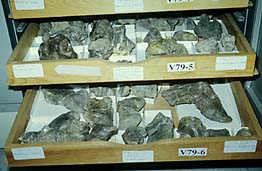What’s Inside a Dinosaur Bone? (cont.) |
||
|
How fast did dinosaurs grow? It turns out that dinosaurs grew at incredibly high rates, as fast as or faster than any living mammal or bird. Far from being sluggish and lizard-like, for example, the duckbill Maiasaura reached seven meters (23 ft.) in length in about seven years. The giant Cretaceous crocodile Deinosuchus took nearly 50 years to get that long, according to recent work by Greg Erickson, a former UCMP grad student, and Chris Brochu of the Field Museum in Chicago. Armand de Ricqlès and his Parisian colleagues found some years ago that the sauropod (think brontosaur) dinosaur Lapparentosaurus reached adult size in about a dozen years, and this result was confirmed for Apatosaurus by Kristi Curry of SUNY-Stony Brook and for Brachiosaurus by Martin Sander of the University of Berlin. Our preliminary studies suggest that Allosaurus, Tyrannosaurus, and their fellow meat-eaters matured at comparable rates. Large pterosaurs (flying reptiles), like these large dinosaurs, grew very quickly, too. Their bone tissues are like those of mid-sized to large birds such as hawks, ducks, turkey vultures, and rheas. And this shouldn’t be surprising, because if you make your living as a flying animal, the sooner your bones mature enough to fly, the sooner you’re in business.
Why did large dinosaurs and pterosaurs grow so fast? |
How could dinosaurs grow so fast?
If you imagine them as typical reptiles of today, they couldn’t. Large living and extinct reptiles still grow like reptiles, with only slightly elevated rates. And they deposit a typically reptilian type of bone. But dinosaurs, because they deposited bone tissues common to birds and mammals, probably had a more advanced metabolic regime than typical reptiles, in order to sustain this rapid growth with a strong flow of blood that carried oxygen and minerals to the growing bones. Does this suggest that dinosaurs were warm-blooded? It certainly doesn’t negate the idea. And, because birds evolved from these rapidly growing dinosaurs, it suggests that avian energetics were largely in place by the time the first birds appeared. That shouldn’t be surprising, because the closest dinosaurian relatives of birds are now known to have had feathers, which automatically would have provided a thermoinsulation that helped to regulate body temperature at a high and relatively constant level. Bone histology is simply another line of evidence that supports this picture, and gives us deeper insight into the biology of the dinosaur.  Drawers in the UCMP collection of Triassic reptiles from Arizona provided the materials to assess how the ancient relatives of crocodiles grew. (photo by Kevin Padian) |
|